Michelle Barker's Blog: Hearing Voices, page 3
July 25, 2022
Patience and Restraint: My Least Favourite Things
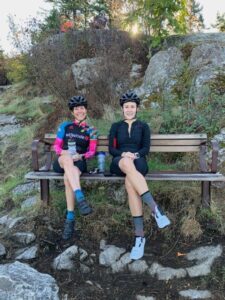
“Now is the time for patience,” my daughter said to me a few days ago.
For anyone who doesn’t already know this about me: I hate patience. I hate being told to move slowly or take it easy or back off a little. None of these things comes naturally to me. Even though I have had ample proof that this is the smartest way to proceed in training, I still balk at the idea of restraint.
What that means in practical terms is an almost cognitive dissonant approach to training—since the only coach I have telling me what to do is me. And I don’t trust myself. So, I have to listen to a wiser version of me tell me what to do. That wiser version is sometimes, in fact, my daughter.

Sometimes it’s my Pilates instructor or my chiropractor. Rarely, oh so rarely, it is me making a decision on my own to do the right thing.
The process usually looks like this.
I get an ache somewhere, something that I know could easily morph into an injury. But I have a long run on my schedule, or a long ride: whatever it is, you can be sure I want to do it. Instead, I have to stop and have a stern talk with myself in which I ask the question: if you were smart, what would you do?
Inevitably, I know the answer. We always do, even if we try to squint and look the other way.
Last week, I did the smart thing—not once, but twice. I mention this only because of how out of character it is. Never in my life do I do the smart thing. I squint, look the other way, and do what I want—even though it rarely has good results.
Last Sunday I’d done a long run that got rushed in the end because of a scheduling squeeze, which meant I ran more than I should have. Of course, my foot was achy the next day. I had a run scheduled for Tuesday and really wanted to do it, but I stopped and asked myself the dreaded question: If you were smart, what would you do? And I knew the answer. I would go aqua-jogging instead.
So I did.
When it came time to run again on Thursday, I was completely recovered. I went on to have an uneventful run both that day and on Saturday and am now fine.
Lesson learned? I wish.
I had to repeat the very same lesson on yesterday’s long ride. I’ve been struggling with low back pain and my chiropractor gave me great advice that I already knew I had little intention of following: stay close to home, so that you can bail when it starts to stiffen up.
Well, that’s no fun. Who wants to do that?
In true rebellious fashion, I went out to Iona, but then I did turn around and came back to do loops of UBC. As I neared the 70K mark, I knew my back was starting to get stiff. I wanted to ignore it and push through to 90. I wanted to ignore it so badly. But damn if that voice didn’t pipe up in my head and say: if you were smart, what would you do?
I would go home. I knew I would.
So I did.
And then I stretched it out and felt fine for the rest of the day, and am still fine, and will likely not have set myself back at all.
Lesson learned? Honestly? Probably not. But the more I listen to that voice, the stronger it gets, and the easier it becomes to do what it tells me.
It’s hard. I hate everything about it. But I think it might be working.
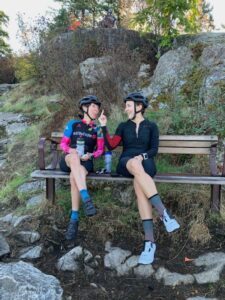
July 18, 2022
Canada Day 4K, 2022

This past Canada Day, I went back to Sasamat for another kick at the VOWSA 4k swim race. It was just as much fun as the last time—and maybe a little less scary because I now know I can swim that length without dying. This was the first real race I’d done since the pandemic, and I was excited. I realized I’d missed racing.
The conditions were perfect. The swim itself was fine—not as fast as the first time, but faster than my Ironman swim and, to be honest, faster than I’d expected. I tend to settle into a rhythm when I swim longer distances where it almost feels as if I’m falling asleep. It’s a nice headspace to hang out in. It’s what keeps me coming back to the lake every weekend for more.
On this Canada Day, when I looked around at all the people who were there to swim various distances, I realized I knew a lot of them—all from this wonderful community of swimmers that exists in Vancouver. I hadn’t appreciated how many people I’d met over the years solely through swimming. It’s such a warm and supportive environment, and I felt proud to be part of it.
As for training in general…
I’m nearing the three-months-out mark, which means distances are ramping up and my hunger level is turning that dangerous corner where I can’t seem to eat enough and simply want to consume EVERYTHING. I’ve made the mistake a few times now of going grocery shopping after a big workout. Inadvisable. I come home with everything from chicken wings to Pop Tarts. And yeah, it all disappears.
My foot injury is slowly getting better. It has been a long exercise in both patience and restraint. Mostly I’ve succeeded in following my physiotherapist’s rules, though yesterday I probably ran longer than I should have and am paying the price today.
But as seems to be the norm with this kind of training, as soon as one injury settles down, a new (old) one rears its head. My lower back has been giving me grief again, so now I have to get that under control.
What have I learned so far this time around? No huge surprises.
Regular massage is essential.Recovery weeks are essential.Too much sitting is deadly.Swim drills might be boring, but they’re the best way to improve technique.Oh, and try not to eat your weight in cheese before going for a run.This time around I’m using interim races to keep me on track. The Kits Challenge happens at the end of July, and I plan to do the Tour de Victoria next month with friends. Hoping to do a Triple Crown in September and some long valley rides over the next few months. And then…Florida. November still feels like a long way away, but I know it will come sooner than I’m ready for it.
I’m excited. And terrified. And excited.
April 21, 2022
And Then Along Came Covid…
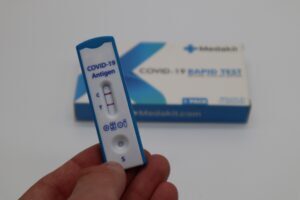
Photo by Medakit Ltd on Unsplash
Talk about taking the wind out of my sails, training-wise. I was triple-vaccinated, and Covid still wiped me out. Two solid weeks with zero energy, and then two more weeks of struggle with nowhere near the intensity or volume of my previous training. I’m more than a month out now and am still battling shortness of breath and a major loss of fitness.
But that’s only one thing.
The bigger surprise has been what Covid has done to my mental training. A month ago, three and a half hours on the trainer was no big deal. When I got back, I struggled to stay on my bike for half an hour. My energy level wasn’t the only problem. The mental toughness was gone. Ditto for swimming. I was in the pool for twenty minutes and thought, man is this over yet? I just want to go home.
Even since my energy has returned, I’ve had to talk myself through several of my workouts. I never appreciated the mental component of training, but it’s huge—at least as important as the physical aspect. If it disappears, you’re hooped.
All I can say is: if you’re preparing for a race that you actually want to do, wear your mask, and don’t go to any indoor gatherings. Seriously. No matter what kind of shape you’re in, this illness can mess you up and set you so far back that you won’t be able to catch up in time. I’ve had to change up my races—not only because of Covid, but also due to a running injury. Penticton will no longer happen for me this year. Instead, I’ll be doing Florida with my daughter in November. It will give me the two extra months that I’m going to need.
Recalculate, as the GPS screams when you’ve made a wrong turn. Such is life.
February 27, 2022
Anything is Possible

For some reason, I was under the illusion that training for this race the second time around would be easier than the first. I’d know more. Most importantly, I’d have one race under my belt and that would give me confidence. One of the biggest issues I had during my training for the first Ironman was self-doubt: could I really do it? I wasn’t sure.
I know now: I did do it. But when I look back, and then look forward to what’s ahead of me, the self-doubt returns in a different form. I did that? How? And how will I ever do it again?
I don’t have a coach this time around. We’ll see if that turns out to be a mistake. But I do know more than I did before. I’ve had two Covid years to work on my swim technique, run long distances, and climb a lot of hills on my bike. I have a pretty good idea of where I need to be in my training and when. I know that the swim distance has to feel easy, so I need to get used to it early. I know how much riding I have to do, and I know not to panic if I need to take a break from running, because the training I do on the bike translates well.
I’ve learned about the immense benefits of taking down weeks and getting regular massages. This fall, I invested in a good, direct-drive trainer and a six-month subscription to Rouvy. I keep an eye on the mileage of my running shoes and change them long before they look like a dog has chewed them. I understand now that every workout must have a purpose, and I’m a wholehearted convert to the 80/20 principle of endurance training (80% easy, 20% hard). These are things that, believe it or not, I didn’t know before. So, that’s progress.
That said, the system isn’t perfect. I’m back to playing Whack a Mole with my running—as soon as I solve one issue, another one pops up. My success with swimming is uneven. Sometimes the technique comes together and suddenly I’m fast. And then…it falls apart again, and regular slow me slogs along, trying to figure out what I’m doing wrong. I have a tendency to get a little too excited about running and put in more miles than I’m ready for. And my skin: don’t get me started on what chlorine and riding are doing to my skin, though I’m keeping on top of it with a lot of antihistamines and a bathroom shelf full of Aveeno products.
One thing I’ve been reminded of in the past few months is that a person can’t be half-hearted about training for this race. You’re either all in or you probably won’t make it to the start line.
But another thing: the system is never perfect. I’d forgotten that. I keep looking for that elusive place where everything is working and I have no aches and pains anywhere. And sure, I feel that way from time to time. But I also feel tired, and little things (and sometimes bigger things) go wrong. Like it or not, that is the process.
It makes me think of how I’m always hopeful when I start writing a novel that I’m going to land it perfectly on the first draft. Great dream. Never gonna happen.
I know what I have to do in the (eek) remaining six months. It will just be a question of listening to my body and ignoring the mental chatter of just because you did it once, doesn’t mean…
No. Anything is possible if you train for it.
February 22, 2022
Fall Seven Times

I grew up skiing downhill and then took up classic cross-country skiing as an adult because I couldn’t stand waiting in lift lineups anymore. Just after Christmas, I got talked into trying skate-skiing. I’ll admit, I was nervous. It turns out you can teach an old dog new tricks, though that old dog might fall down a few times (a few, ha) before they catch on.
Skate-skiing is fun. It’s also hard work. But it’s great cross-training for triathletes (because why be only okay at three sports, when you can be truly crappy at four?). Not only do you get a good cardiovascular workout, but you’re also forced to use your core, as well as working on your balance and challenging muscles that might otherwise get ignored. All of that translates into injury prevention and greater overall fitness.
Cross-country skiing also gives you a break from the impact of running which can be hard on the body.
I’ve been struggling with an Achilles issue for months, and cross-country skiing might be the ideal way for me to strengthen those weakling muscles that are causing so much trouble down the chain.
The Japanese proverb is, “Fall seven times, stand up eight.” I stood up on the eighth time because I wanted the hot chocolate at the lodge. What can I say? Given the right motivation, anyone can do anything.
January 3, 2022
It’s January and You Ate Too Much Cheese
It’s that time of the year again. You’ve done the requisite Polar Bear Dip, taken down the tree, and it suddenly sinks in: you’ve signed up for races in 2022 and now it IS 2022 and you’ll have to do them.
I say you. I mean me.
Unless you happen to be in the same boat.
I plan my workouts on giant-sized monthly calendars that I buy from Staples. I have a whole system that includes colour-coding for when I’ve stretched or done a core workout (that way I can see where I’ve been slacking). I note when I’ve foam-rolled and when I’ve done prehab (again, to prevent slacking). I mark days off and down weeks to remind myself to take them. I also note massage appointments to make sure I’m getting there as often as I need to, and at the end of every week I tally up my mileage so I know I’m not increasing anything too quickly.
If a workout has gone particularly poorly, I also note that. Usually there’s a reason for it, but sometimes I have to take two giant steps away from the calendar to see it.
Sounds obsessive? Sure, okay. But it works, and it keeps me honest. I post it on my wall so that I can see my month at a glance and know where things are at.
Other people have different methods. My daughter likes to use a journal. We were wandering through Granville Island during Cheese Week (the week between Christmas and New Year’s; as opposed to Cookie Week, which is the week before Christmas) when we came upon a Disappointment Journal that was totally hilarious. It was not meant to be used for workouts, but she thought of buying it and using it as one because, let’s face it, training often involves one disappointment after the next.
In lieu of her buying the book, I’ve decided to turn my blogs of 2022 into something of a Disappointment Journal (you’re welcome, Madeleine). Don’t get me wrong. I love the sport more than ever, but I never quite measure up to that athlete in my daydreams—you know, the one who’s moving a whole lot faster and more smoothly than I could ever hope to. I’m reminded of that every time I see a video of myself swimming and remember how hard I was working and how fast I felt, versus how slow I look in reality.
Happy New Year to you all. I hope anyone who’s training for a big race this year will join me in this journey.
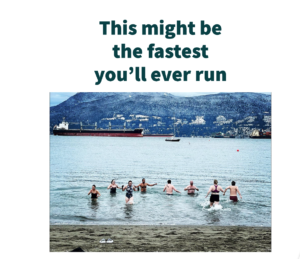
May we work off all the cheese we ate last week.
August 27, 2021
Behind the Scenes: What Happens After No
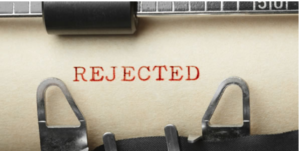
It’s a small word, no, but it can cause a surprising amount of chaos in a writer’s life. Of course, in our present publishing landscape, a writer is lucky if they even hear a no. Usually it’s more like crickets, which (in my opinion) is not only incredibly unhelpful, it’s also rude.
Sometimes, you’ll hear a no, but. No, this isn’t quite for us, but we like your writing; please send more. This is not something publishers say to everyone, so if they say it to you, take them up on their offer.
What’s most helpful is to hear a no, because. No, this isn’t working, and here’s why.
One of my editing clients recently asked me how I approach the process of revision. Given that I’ve received a few no, because’s in the last little while, my feelings on the matter happen to be fresh (or should I say, raw?).
When I get a response like that to my manuscript, I usually spend the first few days railing about how stupid my editors are and how they didn’t get it and don’t know anything, etc. etc.
Then I calm down.
When I’m calm, I realize that my editors are not stupid. In fact, they know a lot, and if they didn’t get it, the fault might lie elsewhere…namely with me.
I read the feedback over many times. I print it out. I sit with it. I walk away from it and then come back, and then walk away again, take some notes, come back. I spend a lot of time thinking. Sometimes it’s necessary to throw the whole manuscript out and start over—but usually not.
That said, I wait until there is a willingness inside me to consider new directions, new ideas. A willingness to throw out certain scenes and completely revise others. A willingness, in short, to listen.
Before I start the actual rewriting, I work out a synopsis in which I tell myself the whole (new) story from start to finish, making sure it hangs together and that I’ve addressed all of my editors’ concerns. If I have questions, I contact the editors and ask them.
I also do not work in a vacuum. I have several other writers whom I rely on to tell me if I’ve put my pants on backwards in a manuscript—and I do the same for them. I can’t stress enough how important it is to have a small team of people who tell you the truth and save you from embarrassment. I wouldn’t dream of sending out anything without their eyes on it first.
Hearing the word no is not fun, but it’s a necessary part of the process. As Ernest Hemingway said, the first draft of anything is shit. The second or third draft might still be a little smelly. That’s not the one you want out in the world with your name on it.
Listen to your editors. Be willing to consider revision in its truest form as a way of re-seeing your story through new eyes. It’s hard, yes. But this is where real writing begins.
August 5, 2021
Behind the Scenes: What Happens After Yes

It’s a writer’s dream: you open that email or get that phone call from a publisher or agent with the big news: they want to publish your novel. It’s actually going to happen—after years of heartache and probably also carpal tunnel syndrome from so much typing.
That day, the day you get the news, is huge. You’ll probably cry. I did. You’ll probably think your life is going to change. I did. People will recognize you on the street. Writing your next book will be so much easier. You’ll lose those ten pounds.
Ummm. No. Or, I should say, not entirely.
One thing that does change is the feeling of validation. Usually, by the time you finally get that yes, you’ve got a lot of no’s under your belt. I mean, A LOT. No’s get heavy after a while. It doesn’t feel good to carry them around. They sink you. In that way, the yes makes a huge difference.
But I would say, in that way only. That one yes does not mean you now have a publisher for life who will accept every golden word you write. Sorry to say this, but you’re only as good as the book you’re writing right now. Every time you write something new, you’re essentially starting over. What you’ve done before doesn’t matter—although what you’ve learned from it definitely does.
As your knowledge of the craft expands, you do get better at putting a novel together. But I would never call it easy. Or rather, it has never been easy for me. I’m able to see the flaws much more quickly and head them off at the synopsis stage, rather than throwing out hundreds of pages of work—though I’m not going to lie. I have thrown out hundreds of pages in my past and will likely do so again.
Another danger is that writers tend to write the same book over and over again. Start book two and you’ll see what I mean. The plot points will be oddly similar to your first book. Even the subject matter might be similar. You’ll get halfway through and think, oh. Damn. Here we go again.
Regardless of how well your first book does, there will suddenly be pressure on you for the second book that you’ve never experienced before. If the first book did well, you’ll feel pressured to measure up to that success. If it did poorly, you’ll feel anxious about doing a better job so the publisher will take the next one.
There are things that happen after you get the phone call that other writers don’t mention. The stress of the editorial process is one of them. Things move quickly, and you’d better be prepared to drop everything and meet your deadlines. By the time you proofread the galleys, you will be so sick of your book, you’ll never want to see it again. You certainly won’t want to read it again.
And then one night you’ll wake up in a sweat with the realization that this novel, which has existed more or less as a secret in your life, will be out in the world for ANYONE to read. You might think this is exciting, and it is. It’s also terrifying. There will be reviews. Not all of them will be good. Or worse, there won’t be reviews. No one will care.
Chances are quite good that no one will recognize you on the street after your first novel is published. Movie producers won’t line up outside your door begging for the screen rights. The blank page will still be blank.
But…there is that validation, and it’s powerful. And there’s experience. You’ll take what you’ve learned and bring it to the next project. And that project will kick your butt all over again, but in a different way, and you’ll have something new to bring to the table for the project after that.
Is it worth all the heartache? If you hesitated for even a second over that question, then the answer is no. There are easier ways to earn a living. But if you’d do this for nothing (and guess what, heh heh), then you’ve come to the right place.
July 28, 2021
Behind the Scenes: The Seed, The Tree

Every writer has their own process for how they start a novel—everything from how long they let an idea percolate, to what they do with it when they decide to sit down and get to work turning it into a book. Even the particular seed they start with—a character, a scene, an idea, an image—varies from one writer to the next.
I keep an idea folder on my laptop and add to it whenever something new and weird pops into my head. Ideas and notes tend to sit there for a few years before I decide it’s time to pull one out and test it, see if there’s really something there. And equally important, see if it’s something I might be willing to devote one to two years of my life working on. Writing a novel is an all-encompassing task. You’d better love what you’ve chosen to write about, otherwise you’ll either spend a lot of time being miserable or you’ll give up on it.
Last week I was perusing my idea folder and came upon some notes for a novel I’d been wanting to write for many years. I had written and published several short stories that included the same few characters. At the time, I’d thought they would grow into a collection of connected stories, but they never did. The stories sat there waiting for me. For whatever reason—I don’t pretend to understand how this process works—suddenly, last week, it was the right time to work on this.
That’s the way it goes for me. I get the idea, I make notes about it, I put it away, and I wait. I go back and look at it and think, yes, it’s a good idea, but it’s not the right time to pursue it. Why? The stars aren’t aligned, Mercury’s in retrograde, I woke up on the wrong side of the bed—who knows? A few months later, I look again. Still a good idea; still not the right time. Months go by, years even, and then—boom, it’s time.
But an idea is not a novel. Not even close. It’s only the seed of what will hopefully mature into a many-branched tree. I’m the type of writer who needs to know what type of tree it’s going to be before I get started. I’ve done it the other way—throwing seeds into the wind—and I know where that leads. All sorts of things grow until you find yourself in a tangle and realize you have to dig it all up and start over. No thanks. It might work for other writers; it doesn’t work for me.
That said, I’m not the type who writes out every scene on index cards either. I’ve tried that, too, and it nearly drove me crazy. Instead, I write a synopsis of about a thousand words where I tell myself the story. I do that a few times, allowing the synopsis to get longer and more detailed. Then I pull out my trusted list of structural elements that are critical to a strong story foundation—things like the inciting incident, the point of no return, the midpoint reversal, the climax—and I make sure they all appear where they need to.
That is maybe the most important part of the process. You might think, Oh, let’s not worry about the midpoint or climax right now. Let’s not talk about character goals. We’ll tackle those things when we get there. No. Worry about them now. Believe me when I tell you, you’ll save yourself a lot of time and heartache. It’s a lot easier to rethink a synopsis than to start a whole novel over again.
Stay tuned, and I’ll talk about where the synopsis goes from there.
June 20, 2021
Writer in Training: Three Mountains—Done
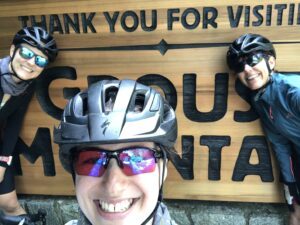
Our day began in typical clown fashion. The weather was questionable. I slept past my alarm and had to scramble to meet my crew on time. But we set off for our first conquest, Seymour, with lots of energy and pockets full of gear and food.
I’d been training on heavy tires to avoid flats, having been warned of a possible tube shortage because of Covid. With all the debris on the roads after winter, this turned out to be a great idea. I didn’t get a flat all spring. But I discovered it was great for another reason, too: when I changed back to my regular tires, everything felt easy. I had no idea how hard I’d been working for the past three months. It was my fastest and most painless climb up Seymour—although I will admit, when it started to rain near the top, I panicked a little, thinking we’d have a rerun of our terrible experience on Cypress just a few weeks earlier.
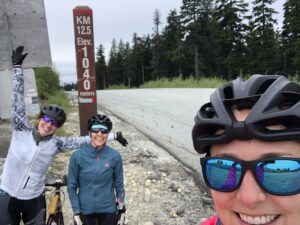
Luckily, it was only a few drops, and this time we were prepared. But we didn’t linger at the top just in case. There were also SO MANY BUGS. Honestly, Seymour has nothing to recommend itself. I can’t think of a single reason to climb it other than because it’s there. It’s long, steep, and unrelenting.
Besides which, getting there and back is a nightmare. We left early on purpose to avoid traffic, but by the time we were coming down, we were in the thick of it. I know there are bike detours in spots to keep you out of the bridge traffic, but we don’t know our way well enough to use them. So, that wasn’t fun.
But Grouse was a bright spot. The great thing about Grouse (besides being short) is that I never remember when the end is coming and am always surprised. I tell myself, I know there’s one last nasty climb, and invariably realize I’ve already done it. And, bonus: there’s food at the top. We stopped for much needed coffee and breakfast sandwiches.
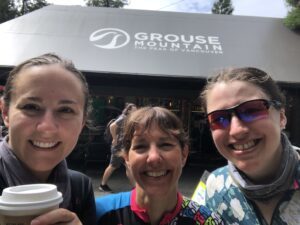
And then on the way down, one of our crew got a flat. I have a lot of practice changing tires, but not a lot filling them with CO2. Thank goodness we had a hand pump. It took us much longer than it should have to solve the problem—a long story involving major clown energy that I’m just not going to tell.
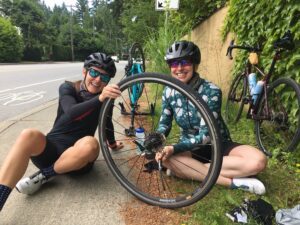
However, we were determined this would not end our day—and it didn’t. Bottom line: I’m done with C02. Hand pumps are more reliable, which is something I never thought I’d say. One of our crew has carried a hand pump from day one and we’ve made fun of her for months because of it. Yesterday we all had to eat our words. The hand pump saved us.
Onto Mountain Number Three: Cypress. Having found a way up from Marine Drive that wasn’t totally incapacitating, we began the last climb. No one was talking anymore. And then one of our crew started bonking hard. The trouble is, by the time you realize you’re hungry, it’s too late. You have to eat early and often before hunger hits. But again, we were determined that all three of us would make it to the top. We pooled our resources and kept going until we got the job done.
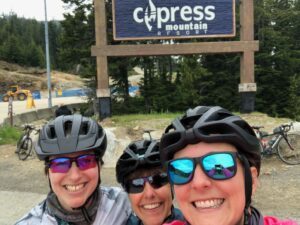
The day ended with beer, chips, and a well-deserved celebratory meal of burgers and fries.

It’s good to come away from a long ride like this having learned something, and we definitely did. The triple crown is a challenge of training, planning, and determination—and a little luck with things like weather and mechanical failure. In the end, there’s nothing like the feeling of getting to the top of that third climb. 146km, door to door; almost 2700m of elevation; a lot of chafe. Would we do it again? Absolutely.
Hearing Voices
This is a blog for writers and readers who love to hear voices. ...more
- Michelle Barker's profile
- 61 followers



